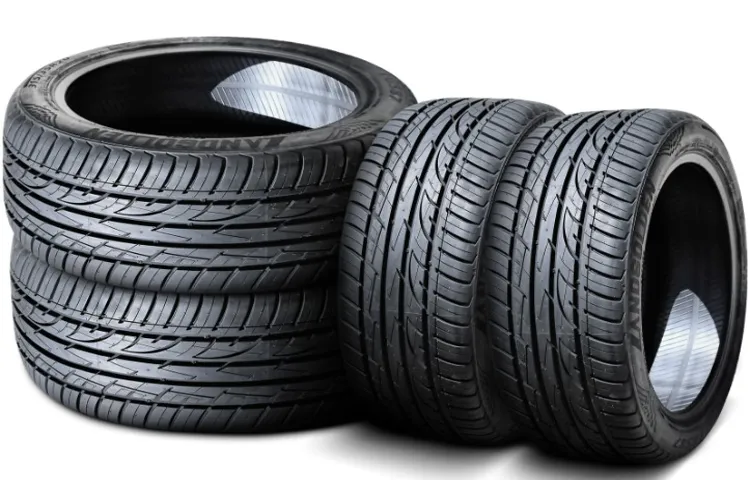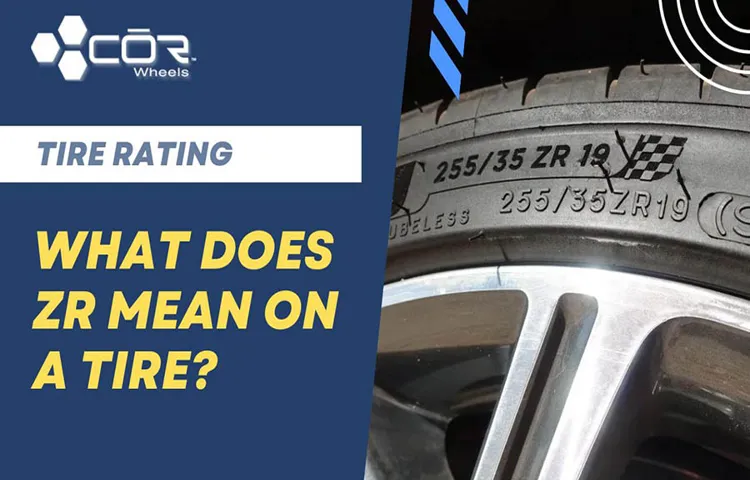Have you ever stared at the sidewall of your tire and stumbled upon the perplexing code “ZR”? What does it mean? Don’t worry! You don’t have to be a tire expert to understand its significance. Whether you’re a car enthusiast or a new driver, it’s essential to know how to decipher the markings on your tire. In this blog, we’ll explore the meaning of ZR on a tire and why it matters.
Think of it as your personal tire decoder! So, buckle up, and let’s dive in!
Table of Contents
Understanding Tire Markings
Have you ever noticed the letters “ZR” on your tire? This marking actually indicates the tire’s speed rating, specifically referring to the maximum speed the tire can safely handle. The “Z” denotes that the tire is rated for speeds over 149 mph, while the “R” signifies that it is a radial tire. But don’t be fooled into thinking that you should be driving that fast! Speed limits are in place for a reason, and it’s important to always drive responsibly and within the legal limit.
However, it is important to ensure that your tires’ speed rating matches the intended use of your vehicle to ensure optimal performance and safety. So, the next time you see “ZR” on a tire, you’ll know exactly what it means!
Decoding Tire Markings
Tire markings can be confusing and overwhelming, but they hold important information about the size, type, and performance of the tire. Understanding tire markings can save you time and money when looking for the right tires for your vehicle. The markings on a tire include a series of numbers and letters, which can be decoded to determine the tire size, load index, speed rating, and other specifications.
For example, the first three digits indicate the tire width, while the next two digits represent the aspect ratio or the relationship between the tire’s height and width. The last two digits are the wheel diameter, expressed in inches. In addition, each tire has a load index and a speed rating that tell you how much weight the tire can safely carry and how fast it can go.
Overall, deciphering tire markings is essential to finding the right tire for your vehicle and ensuring optimal performance and safety on the road.

Tire Width, Aspect Ratio, and Construction Type
If you’re in the market for new tires, it’s important to understand the markings on the sidewall. The first three digits indicate the tire width in millimeters, followed by the aspect ratio, which is the height of the tire sidewall as a percentage of the width. For example, a 225/50 tire would have a width of 225 millimeters and an aspect ratio of 50 percent (11
5 mm). The next letter indicates the tire’s construction type, such as “R” for radial tires. The next number represents the wheel diameter in inches.
Knowing these markings will help ensure that you choose the right tire size for your vehicle. It’s worth noting that not all tire sizes will fit all vehicles, so always be sure to check your vehicle manual or with a professional before making a purchase. Ultimately, finding the right tire size and construction for your vehicle can help improve handling, traction, and overall safety on the road, making it a worthwhile investment.
Explaining ZR Rating
If you’ve ever shopped for tires, you might have come across the term “ZR” on them. The ZR rating on a tire indicates that it is designed for high-speed driving. The “Z” refers to the speed rating, which means that the tire is capable of handling speeds of more than 149 mph.
The “R” is the type of tire construction, which means that it is a radial tire. Radial tires are constructed with layers of steel or polyester cord running at 90-degree angles to each other, providing a smoother ride and better handling. Essentially, the ZR rating indicates that you have a tire that is designed to handle high speeds on the highway but still provide a comfortable ride.
So the next time you see the ZR rating on a tire, you’ll know what it means and what you can expect from it on the road.
Speed Rating and Load Index
When it comes to understanding speed and load ratings for tires, it can be overwhelming for the average consumer. One rating that often causes confusion is the ZR rating. The ZR rating is typically found on high-performance tires and stands for “Z-speed rating.
” This rating indicates that the tire can handle speeds of over 149 mph. However, the ZR rating doesn’t only take speed into account, it also considers load capacity, meaning the tire can withstand the weight of a high-performance vehicle. To break it down, the letter Z indicates that the tire has a maximum speed rating of over 149 mph, while the letter R indicates that the tire has a radial construction.
So, if you’re looking for a tire with the highest speed rating and load capacity, look for tires with the ZR rating. It’s important to note that these tires may not be necessary for everyday driving, and it’s crucial to check your vehicle’s manufacturer recommendations to ensure you’re purchasing the right tires for your car.
What Does ZR Indicate?
If you’ve ever shopped for tires, you’ve likely come across the term “ZR” followed by a number on the sidewall. So, what does ZR indicate? ZR is a speed rating that indicates the tire can handle higher speeds than a standard passenger tire. The “Z” part of the rating indicates the tire can handle speeds above 149 mph (240 km/h), while the number following it indicates the specific speed rating.
For example, a ZR-93 rating indicates a tire can handle speeds up to 186 mph (300 km/h). It’s important to note that ZR-rated tires are generally only found on sports cars and other high-performance vehicles, and should not be used on standard passenger cars. When shopping for tires, remember to check the speed rating to ensure safe and reliable performance on the road.
ZR vs. W and Y Ratings
When it comes to tires, there are various types and ratings to consider. One of the rating systems used is the ZR rating. This rating is used for high-performance tires that are capable of achieving speeds of 149+ mph (240+ km/h).
The ZR rating also indicates that the tire has undergone extensive testing and meets specific quality standards. On the other hand, the W and Y ratings are also used for high-performance tires, but they have lower speed ratings compared to the ZR rating. W-rated tires are capable of achieving a maximum speed of 168 mph (270 km/h), while Y-rated tires can go up to 186 mph (299 km/h).
In short, the ZR rating is the highest rating for performance tires, indicating that they are designed for high-speed driving and are built to meet strict quality standards. So if you are looking for speed and performance, look for tires with the ZR rating for a safe and thrilling driving experience.
Conclusion
In conclusion, the mysterious “ZR” on a tire is not some secret code or alien language, but rather a symbol of high-performance potential. The “Z” refers to the tire’s speed rating, indicating it’s capable of speeds up to 149 mph (240 km/h), while the “R” simply signifies that it’s a radial tire construction. So, the next time you see “ZR” on a tire, rest assured that you’re rolling on a tire that’s designed to handle some serious speed and performance.
Just remember to obey the speed limit on public roads!”
Making Sense of Tire Markings
Tire markings can seem like a foreign language to many drivers. With so many letters, numbers, symbols, and codes on your tires, it’s easy to get lost in translation. One of the most confusing tire markings is the ZR rating.
Simply put, the ZR rating refers to the maximum speed a tire can handle. The letter Z indicates a top speed of over 149 mph, and the R stands for radial construction. So, if you see a tire with a ZR rating, you can rest assured that it’s designed to handle high speeds and provide superior performance.
However, it’s important to note that not all cars require ZR rated tires. If you’re unsure what tires are right for your vehicle, consult your owner’s manual or speak with a professional. When it comes to tire safety, it’s always better to err on the side of caution.
FAQs
What does “ZR” stand for on a tire?
“ZR” stands for “Z-speed rating,” which indicates the maximum safely sustainable speed of the tire.
Can any car use tires with a “ZR” rating?
No, “ZR” rated tires are high-performance tires designed for sports cars and high-performance vehicles. Using them on a vehicle that isn’t designed for them could result in poor performance and safety risks.
What is the maximum speed that a tire with a “ZR” rating can handle?
A tire with a “ZR” rating can handle speeds up to 149 mph, depending on the specific rating code.
Are “ZR” rated tires more expensive than regular tires?
Yes, “ZR” rated tires are generally more expensive than regular tires due to their specialized design and high-performance capabilities.
Can I mix “ZR” rated tires with non-“ZR” rated tires on my car?
It is not recommended to mix “ZR” rated tires with non-“ZR” rated tires on the same car, as it could result in uneven performance and handling.
How can I tell if a tire has a “ZR” rating?
“ZR” rated tires have this designation indicated in the tire’s size code, typically following the tire’s width and aspect ratio numbers.
Are “ZR” rated tires suitable for use in all weather conditions?
No, “ZR” rated tires are designed for high-performance driving in dry weather conditions. Using them in wet or snowy conditions could result in reduced performance and safety risks.


